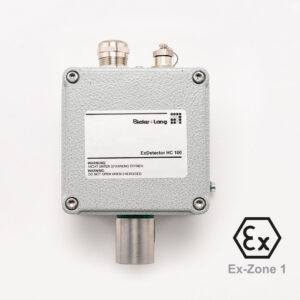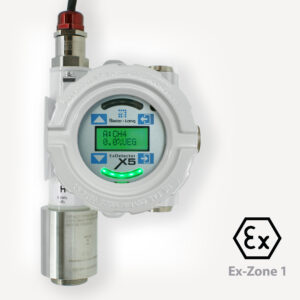Ammonia (NH₃)
Reliably detect ammonia with Bieler+Lang gas warning technology
General information about ammonia
Ammonia (NH₃) is a colorless gas with a pungent odor that consists of hydrogen (H₂) and nitrogen (N₂). It is not only an important chemical raw material, but is also becoming increasingly important as a hydrogen storage and carrier in the energy transition. Ammonia (NH₃) is also used in many industrial processes such as fertilizer production and refrigeration technology.
It is highly toxic and in high concentrations can irritate the respiratory tract or cause serious damage to health. Ammonia is also explosive when mixed with air.
Precise monitoring of ammonia concentrations is therefore crucial for the protection of employees and the environment. Our gas measurement and warning systems ensure that ammonia leaks are detected at an early stage and appropriate safety measures can be taken.
Ammonia in the hydrogen industry: storage + applications
Why ammonia for hydrogen storage?
The direct storage of hydrogen is technically complex, as it is an extremely light and volatile gas. In order to store or transport large amounts of energy efficiently, conversion into ammonia is an option.
Advantages of ammonia as a hydrogen carrier:
- Higher energy density than gaseous or liquid hydrogen
- Easy storage and transportation – at moderate pressures and temperatures
- Existing infrastructure (e.g. tankers, pipelines, storage containers from the chemical industry)
- CO₂-free reconversion possible if powered by renewable energy
The chemical process: hydrogen to ammonia and back again
1st synthesis – from H₂ to NH₃:
In the Haber-Bosch process, ammonia (NH₃) is formed from nitrogen (N₂ from the air) and hydrogen (H₂ from electrolysis or reforming) at high temperature and high pressure: N₂ + 3H₂ → 2NH₃
This reaction is exothermic (releases energy) and has been used industrially for decades.
2. reverse conversion – from NH₃ to H₂:
Ammonia can be split back into hydrogen and nitrogen for use as an energy source – using so-called cracking plants: 2NH₃ → N₂ + 3H₂
This conversion requires energy, but is becoming increasingly efficient.
Application in shipping
The maritime industry is considered a key sector for the use of ammonia:
- Ammonia as a marine fuel:
Due to its high energy density and emission-free combustion (no CO₂), ammonia is being tested as a climate-friendly fuel for large cargo ships. - Drive technologies:
Ammonia can be used directly in specially developed combustion engines or fuel cells. The first pilot projects are already underway (e.g. in Japan, Norway and South Korea). - Safety and challenges:
Ammonia is toxic and requires appropriate safety measures on board and in port operations.
Application on land
Ammonia is also increasingly being used as a hydrogen storage medium on land:
- Energy backup systems for industry and data centers
- Long-term storage for renewable energies
- Pipelines for the distribution of hydrogen over long distances in the form of ammonia
- Decarbonization of industrial processes, e.g. steel production
Conclusion: ammonia as the key to the hydrogen economy
Ammonia offers a realistic solution to many of the challenges of hydrogen logistics – especially for international transportation and large-scale use. The ability to store, transport and recover hydrogen efficiently makes ammonia a key component of the global hydrogen economy. Important areas in which suitable gas detection systems are used:
- Ammonia as a hydrogen storage medium
- Hydrogen transport with ammonia
- Ammonia as a marine fuel
- NH₃ Cracking hydrogen
- Hydrogen logistics shipping
- Ammonia reconversion
- Hydrogen economy infrastructure
Reliable warning of ammonia leaks with Bieler+Lang
For many industries, accurate and rapid detection of ammonia is important to prevent the gas from reaching dangerous toxic levels. Discover our range of ammonia monitors and associated instruments. They have been specially developed for the detection of ammonia.





